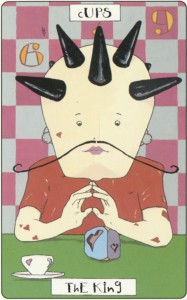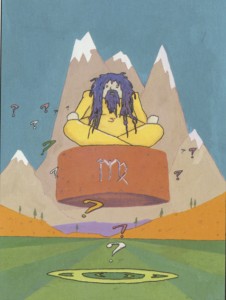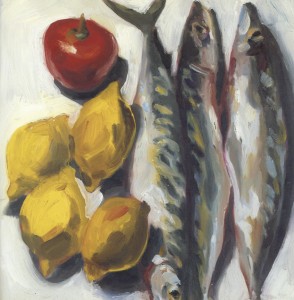Right Practice
Again from The Island: An Anthology of the Buddha’s Teachings on Nibbana, by Ajahn Pasanno and Ajahn Amaro:
 “The fourth and final factor for stream-entry is dhammanudhammapatipatti. This is usually translated as ‘practice in accordance with the Dhamma,’ but it can have some other subtle nuances, such as practicing Dhamma appropriately according to the truth. There are many ways of practice but some of them may, in actuality, not accord with the teachings or the true Way. They may be popular or comfortable, but yet not be Dhamma…..
“The fourth and final factor for stream-entry is dhammanudhammapatipatti. This is usually translated as ‘practice in accordance with the Dhamma,’ but it can have some other subtle nuances, such as practicing Dhamma appropriately according to the truth. There are many ways of practice but some of them may, in actuality, not accord with the teachings or the true Way. They may be popular or comfortable, but yet not be Dhamma…..
“Another meaning of the phrase is making sure one follows the Dhamma as one has studied it, rather than studying one thing and then practicing in a completely different manner.”
So then I guess it’s not enough to just read about all this. Or think about it. One actually has to practice it. Right?
Right.
(image: Steampunk Tarot by Curly Cue Design)
Pay Careful Attention
 More from The Island: An Anthology of the Buddha’s Teachings on Nibbana, by Ajahn Pasanno and Ajahn Amaro:
More from The Island: An Anthology of the Buddha’s Teachings on Nibbana, by Ajahn Pasanno and Ajahn Amaro:
The second factor for stream-entry is hearing the true Dhamma (saddhammassavana) and the third is careful attention (yoniso-manisakara). “This term can be translated in many ways — wise consideration, skillful reflection, clear thinking, appropriate attention, keen application of mind. The importance of this element in the development of qualities useful for understanding and penetrating truth cannot be underestimated.”
And what should we be paying careful attention to?
“He attends wisely: ‘This is suffering;’ he attends wisely: ‘This is the origin of suffering;’ he attends wisely: ‘This is the cessation of suffering;’ he attends wisely: ‘This is the way leading to the cessation of suffering.’ “— from Majjhima Nikaya 9-11, translated by Bhikkhu Nanamoli and Bhikkhu Bodhi
Oh yeah. That.
(image: Phantasmagoric Theater Tarot)
Choose Wisely
According to the Samyutta Nikaya, the first of the factors of stream-entry is “association with superior persons.”
A man who wraps rotting fish
in a blade of kusa grass
makes the grass smelly:
so it is
if you seek out fools.
But a man who wraps powdered incense in the leaf of a tree
makes the leaf fragrant:
so it is
if you seek out
the enlightened.
— from the Itivuttaka, translated by Thanissaro Bhikkhu
(image: “A Whole World,” by Couprie and Louchard)
That Which Keeps Us Bound
 “The Ten Fetters” (samyojana) is one of the topics of this month’s DPP homework…which is preparing us for the up-coming retreat on Nibanna. “Fetters” is not a word I use in every-day conversation. But I understand what it means — something that keeps us from moving forward, that holds us back, that keeps us bound.
“The Ten Fetters” (samyojana) is one of the topics of this month’s DPP homework…which is preparing us for the up-coming retreat on Nibanna. “Fetters” is not a word I use in every-day conversation. But I understand what it means — something that keeps us from moving forward, that holds us back, that keeps us bound.
This is part of our readings for this month. It’s from The Isalnd: An Anthology of the Buddha’s Teachings on Nibbana, by Ajanh Pasanno and Ajahn Amaro:
“Although some people may be quicker than others in reaching the goal, the structure of the unfolding insight is common to all. The most familiar description of the stages of realization contains four levels: the stream-enterer (sotapanna), the once-returner (sakadagami), the non-returner (anagram) and one fully enlightened (arahant). These levels are differentiated according to the ‘fetters’ (samyojana) that a liberated person relinquishes at each stage:
Bhikkhus, there are these five lower fetters. What five? Identity view, doubt, the distorted grasp of rules and vows, sensual desire, ill will. These are the five lower fetters. — Samyutta Nikaya 45.179, translated by Bhikkhu Bodhi
Bhikkhus, there are these five higher fetters. What five? Lust for form, lust for the formless, conceit, restlessness, ignorance. These are the five higher fetters. — Samyutta Nikaya 45.180, translated by Bhikkhu Bodhi”
Later on in the text: What now, Sariputta, is a factor for stream-entry? Association with superior persons, venerable sir, is a factor for stream-entry. Hearing the true Dhamma is a factor for stream-entry. Careful attention is a factor for stream-entry. Practice in accordance with the Dhamma is a factor for stream-entry…. One who possesses this Noble Eightfold Path is a stream-enterer. — Samyutta Nikaya 55.5, translation by Bhikkhu Bodhi.
When he attends wisely in this way, three fetters are abandoned in him: personality view, doubt and adherence to rules and observances. These are called the taints that should be abandoned by seeing. — Majjhima Nikaya 2.3 & .9-11 translation by Bhikkhu Nanamoli & Bhikkhy Bodhi
And: “The Eightfold Path which is equated with the stream is often characterized as being composed of three trainings — virtue, concentration (or the higher mind) and wisdom…..If the factors of the path are fulfilled partially, one is able to realize stream-entry. If you fulfill them more completely, you’ll reach the higher attainments. For stream-entry, full accomplishment in virtue is necessary, but only partial accomplishment in concentration and wisdom.”
(image: “Creative Whack Pack,” by Roger von Oech)
Fellow Travelers
 How joyful to look upon the awakened
How joyful to look upon the awakened
And to keep company with the wise.
Following then the shining ones,
The wise, the awakened, the loving,
For they know how to work and forbear.
But if you cannot find
Friend or master to go with you,
Travel on alone–
Like a king who has given away his kingdom,
Like an elephant in the forest.
If the traveler can find
A virtuous and wise companion
Let him go with her joyfully
And overcome the dangers of the way.
Follow them
As the moon follows the path of the stars.
— from the Dhammapada, translated by Thomas Byrom (with gender pronouns edited by me)
— image from Steampunk Tarot by Curly Cue Design
Temporary Nibbana
 One of the readings from this month’s DPP homework is Nibbana for Everyone, by Buddhadasa Bhikkhu (translated by Santikaro Bhikkhu). He writes:
One of the readings from this month’s DPP homework is Nibbana for Everyone, by Buddhadasa Bhikkhu (translated by Santikaro Bhikkhu). He writes:
“The word ‘nibbana‘ means ‘coolness.’ Back when it was just an ordinary word that people used in their homes, it meant ‘coolness.’ When it is used as Dhamma language, in a religious context, it still means ‘coolness,’ but refers to the cooling or going out of the fires of defilement (kilesa, reactive emotions), when in common people’s usage it means the cooling of physical fires….
“Any reactive emotion that arises cease when its causes and conditions are finished. Although it may be a temporary quenching, merely a temporary coolness, it still means Nibbana, even if only temporarily…This indeed is the temporary Nibbana that sustains the lives of beings who are still hanging onto defilement [greed, hatred and delusion].
“Anyone can see that if the egoistic emotions exist night and day without any pause or rest, no life could endure it. You ought to consider carefully the fact that life can survive only because there are periods when the defilements don’t roast it, which, in fact, outnumber the times when the defilements blaze…
“Every time the defilements [greed, hatred and delusion] don’t appear, Nibbana becomes apparent to the mind. This kind of Nibbana nourishes the lives of living things so they survive and don’t go crazy…We can experience Nibbana here and now by breathing in cool and breathing out cool. It is the automatic quenching of heat, of thirst, of dukkha [suffering] in ordinatry life, even without our being conscious of it. It is the eternal nourishment and sustenance of life.”
(image: “A Whole World,” by Couprie and Louchard)
Also Known As…
Another part of the DPP homework for this month is to read Mind Like Fire Unbound, by Thanissaro Bhikkhu. In it, he lists a series of similes for nibbana, collected from the Samyutta Nikaya, and our homework assignment is to reflect on these terms. We are asked: “Which ones do you find inspiring? Spend some time allowing yourself to connect with the inspiration of those terms. Do some of them feel uninspiring? Why?” Here’s the list:
 the Unfashioned
the Unfashioned
the End
the Effluent-less
the True
the Beyond
the Subtle
the Very-Hard-to-See
the Ageless
Permanence
the Undecaying
the Surface-less
the Non-Objectification
Peace
the Deathless
the Exquisite
Bliss
Solace
the Exhaustion of Craving
the Wonderful
the Marvelous
the Secure
Security
Nibbana (which literally translates as “coolness”)
the Unafflicted
the Passionless
the Pure
Release
Non-Attachment
the Island
Shelter
Harbor
Refuge
the Ultimate
(image: House of a Thousand Paintings by Sanford Darling)
Trying to Go Somewhere?
 Ajahn Sumedho says:
Ajahn Sumedho says:
“The important thing in meditation is attitude, rather than technique or tradition. The right attitude is most important. Even if you have the best teacher with the best tradition and the best method, if your attitude isn’t right, it won’t work….
“When you are meditating, don’t try to attain, but just open up to your intention for meditating. When you suddenly awaken to the fact that you are trying to get something out of it, that is a moment of enlightenment. With an open mind, you begin to see what is really happening. But if you sit for a year trying to become and attain, you will feel terribly disappointed at the end of it. You will have lost everything because, if you don’t have the right attitude, you will not have the wisdom to learn from failure.
“In our meditation, we learn from both successes and failures. People fail all the time. Mindfulness of the breath is one of the most frustrating meditation practices ever conceived because, if you try to get something out of it, it is not a very giving practice. You have to be patient. You have to learn from your successes and from your failures, until you no longer really care whether your experience is pleasant or unpleasant. Then both conditions can take you to enlightenment, to nibbana.”
–text from The Mind and the Way: Buddhist Reflections on Life
–image from Phantasmagoric Theater Tarot
Luminous is the Mind
 Luminous is the mind, brightly shining, but it is colored by the attachments that visit it. This unlearned people do not really understand, and so do not cultivate the mind.
Luminous is the mind, brightly shining, but it is colored by the attachments that visit it. This unlearned people do not really understand, and so do not cultivate the mind.
Luminous is the mind, brightly shining, and it is free of the attachments that visit it. This the noble follower of the way really understands; so for them there is cultivation of the mind.
— from the Anguttara Nikaya, translated by Gil Fronsdal
“Me”
Here’s another of the DPP homework assignments for this month, focusing on anatta (the Buddhist teaching of “not-self.”)
 Make a list of the various identities you catch yourself assuming in the course of a day, both the identities you assume in dealing with other people, and the identities you assume in your internal conversations. (Who is talking to whom in your mind?) Try to notice which events cause you to switch from one identity to another.
Make a list of the various identities you catch yourself assuming in the course of a day, both the identities you assume in dealing with other people, and the identities you assume in your internal conversations. (Who is talking to whom in your mind?) Try to notice which events cause you to switch from one identity to another.
OK. Here goes:
The Very Dedicated Buddhist Practitioner.
The Woman of a Certain Age.
The Enthusiastic Student of All Things Italian.
The Creative Person, with a Strong Sense of Graphic Design.
The Couch Potato.
The Account Executive.
The Vegetarian.
The Writer of Many E-Mails.
The Outrageous Auntie.
The Expert.
The Critic.
The Responsible One.
The Traveler.
The Grammarian.
The Collector of Tarot Cards.
I could go on and on. But I think the most interesting part of this assignment is noticing what brings any one of these “beings” into being, and what makes them stay or go away.
(image: Steampunk Tarot by Curly Cue Design)

